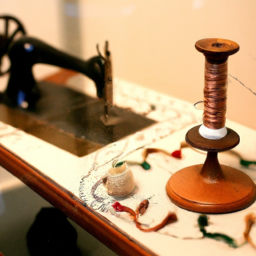
Sewing machines revolutionized the textile industry and forever changed the way in which clothes and other fabrics were manufactured. The invention of the sewing/” title=”Stitching Stories: A Beginner's Guide to Sewing”>sewing machine was a significant milestone in the history of technology, offering numerous benefits over traditional hand sewing methods.
The need for increased efficiency
Prior to the invention of sewing machines, all sewing had to be done by hand. This process was time-consuming and labor-intensive, limiting the production capacity for garments and fabrics. Recognizing the need for increased efficiency in the textile industry, numerous inventors worked to find a solution that would streamline the sewing process.
Elias Howe and Isaac Singer
Two of the most prominent figures in the development of sewing machines were Elias Howe and Isaac Singer.
In the mid-19th century, Howe successfully patented the first practical sewing machine design in 1846. His machine utilized a lockstitch mechanism and a needle with an eye at the point, allowing for continuous stitching without the need to constantly rethread the needle.
Singer further improved upon Howe’s design and significantly popularized the sewing machine. In 1851, Singer secured a patent for his own version of the sewing machine, incorporating various innovations and refinements. His machine boasted a foot pedal, which enabled hands-free operation and increased speed and precision. Singer also introduced the concept of interchangeable parts, making maintenance and repairs easier.
Impact on industrial production
The introduction of sewing machines led to a dramatic increase in the productivity and output of the textile industry. Manufacturers could now produce clothes and fabrics much faster and in larger quantities. This had a profound impact on the availability and affordability of clothing, making it more accessible to a wider population.
Furthermore, the invention of sewing machines enabled the creation of more complex designs and intricate stitching patterns that were nearly impossible to achieve by hand. This opened up new possibilities in fashion and allowed for the manufacturing of higher-quality garments.
Social and economic implications
The sewing machine brought about significant social and economic changes. Women, who traditionally bore the responsibility of sewing, were now able to transition into different forms of work and contribute to the workforce outside their homes. This newfound independence had a profound impact on gender roles and women’s rights.
Additionally, the affordability of machine-made clothing meant that people from different socio-economic backgrounds could access a broader range of garments. Fashion became more accessible and not limited to the wealthier classes who could afford custom-made clothes.
Continued relevance
While the sewing machine has certainly evolved since its inception, it remains a vital tool in the textile industry. Industrial sewing machines have become more advanced and specialized, allowing for increased automation and efficiency in production. Domestic sewing machines continue to be popular among hobbyists and home seamstresses, providing them with the ability to create their own unique garments or carry out repairs.
The invention of sewing machines has had a lasting impact on society and played a crucial role in shaping the modern textile industry. Without this groundbreaking invention, the world of fashion, manufacturing, and even women’s rights would look vastly different today.




